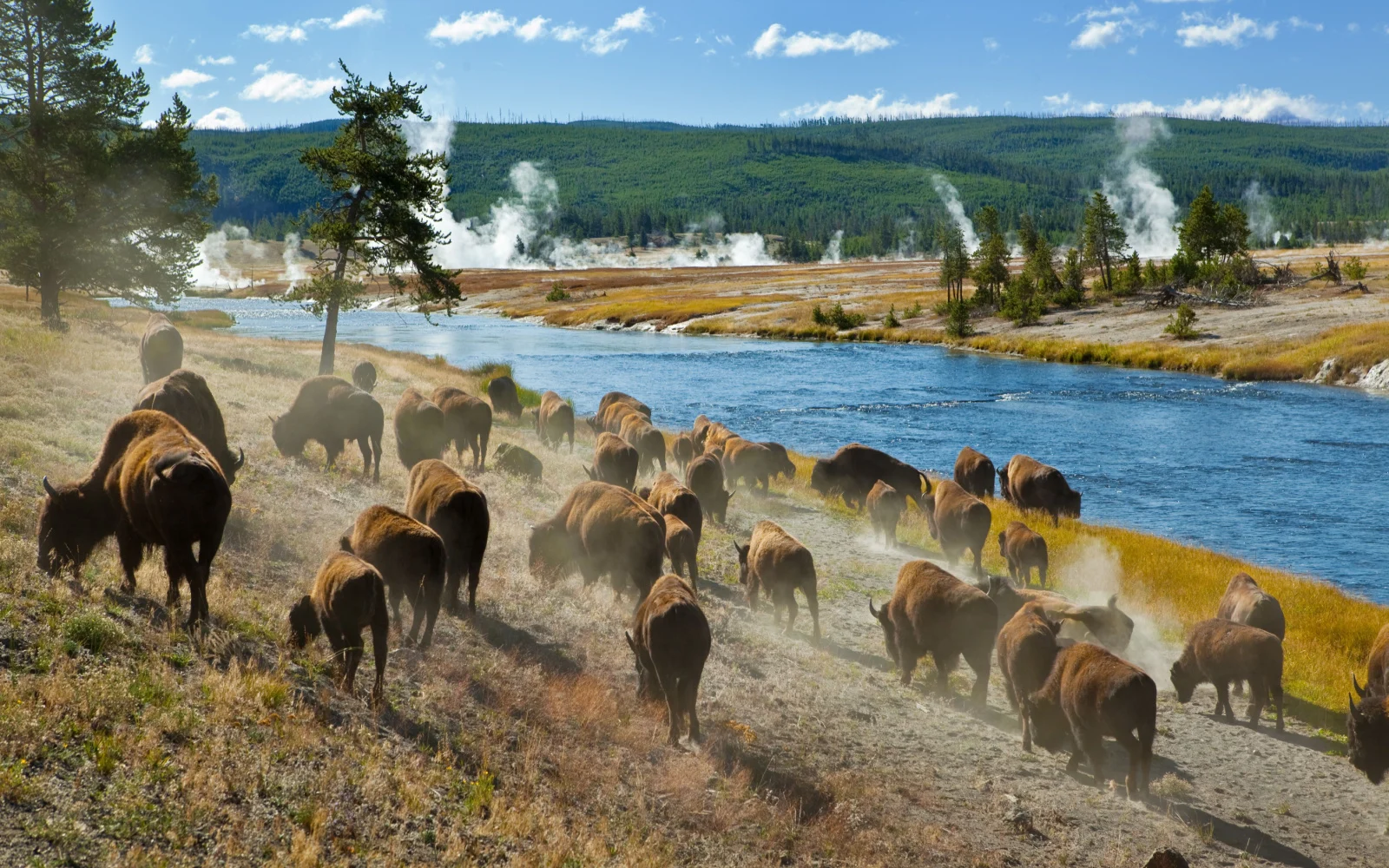What's the average trip to Yellowstone cost in 2025?
A trip to Yellowstone can cost anywhere from $500 to $3,500+ for two people, depending on your travel style. Budget options like camping and self-catering can keep costs low, while staying in park lodges and flying in can be more expensive. A 7-day park pass costs $35, and rental cars typically run $70-$80 per day.
Yellowstone National Park is the crown jewel of the American park system. At 3,472 square miles, it’s not only bigger than Rhode Island and Delaware, it’s bigger than both of them put together.
The park has it all: geysers, paint pots, lakes and even its own Grand Canyon. That’s not to mention almost 400 animal species, including black bears, grizzly bears and bison.
If you don’t visit Yellowstone at least once during your lifetime, you’re missing out on an iconic American experience.
Furthermore, you don’t have to spend a fortune for your adventure. Sure, you can take a dent out of your wallet if you travel in style, but Yellowstone is waiting and available for anyone who wants to drive through.
Read on for some insight into what it might cost to fly in and stay in comfortable park accommodations, and also on how you can manage the trip for a whole lot less.
Average Trip to Yellowstone Cost in 2025
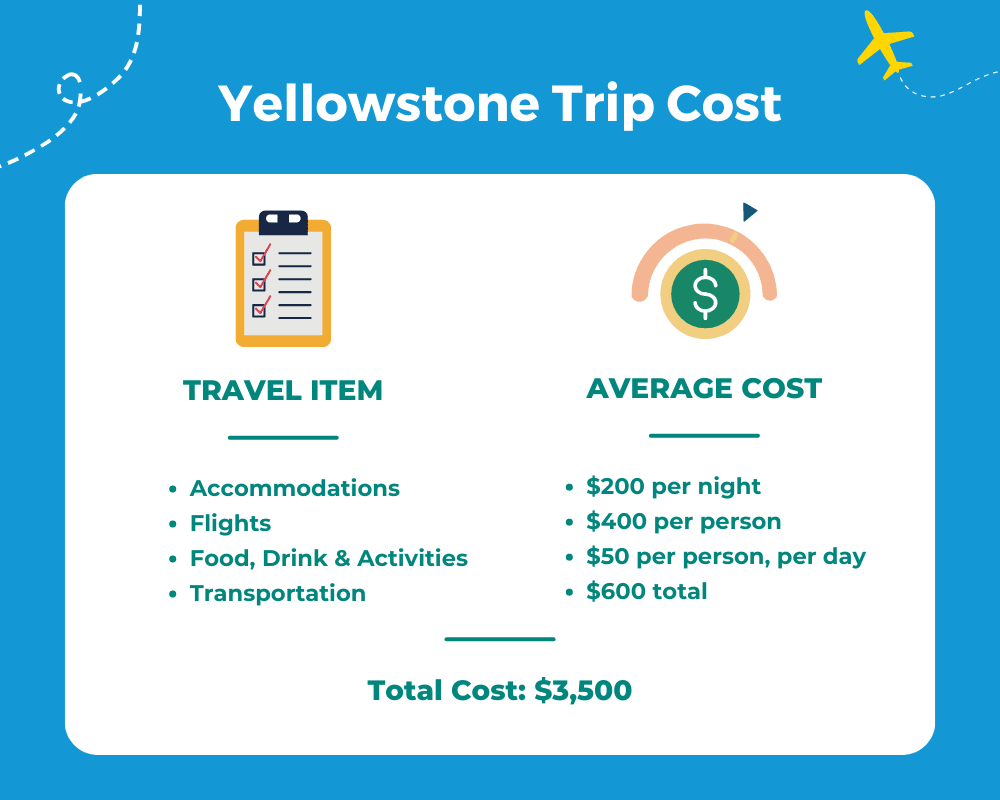
If you fly into Yellowstone, rent a car and stay in the lodges, a week-long trip for two will cost around $3,500:
- Average Accommodation Cost: $200 per night
- Average Flight Cost: $400 per ticket
- Food, Drink & Activities: $50 per person per day
- Transportation: $600 total
- Total Cost: $3,500
You can make the journey for less. In some cases, very much less. If you throw your tent into the back of your SUV and drive from home, expenses are minimal once you’ve arrived.
Bag your lunches and cook meals at the campgrounds, and you might spend $500 or even less. (Of course there’s also the expense of driving to Yellowstone from wherever you live.)
If you do drive, be aware that there’s limited access from mid-November to mid-April. During that time, the park is best visited by snowcoach or snowmobile.
At the other cost extreme are the all-inclusive packages, which could run from $1,000 per person for four nights up to $5,000 and more (plus flight costs). With these, a coach picks you up every morning at your hotel and guides you through the day’s sightseeing.
Ready to Book?
Unlock Exclusive Discounts on Expedia.com!
Got Travel Insurance?
Protect yourself for unexpected interruptions.
Compare Plans We may be compensated when you book after clicking on one of our links.Yellowstone Trip Cost: Average by Item
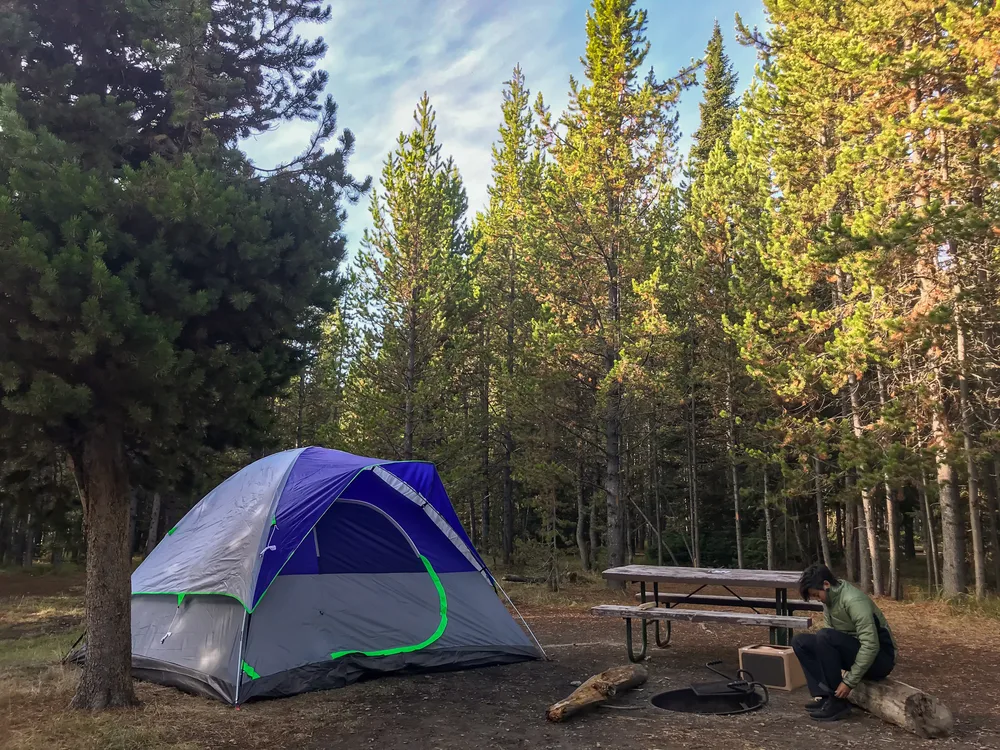
Jayjay Adventures/Shutterstock
Accommodation Costs
Staying at a park lodge or nearby hotel is on the expensive side. In-park lodges start around $135 at some locations or about $250 at the most popular ones. A suite at the Old Faithful Inn is upwards of $700 per night.
Out-of-park accommodations in the gateway communities are less, with prices quoted from $75-$200. Cabins in those ares offer more privacy but also cost more, ranging from $150-$400.
Camping, on the other hand, is quite reasonable. Campsites cost $20-$40 per night and include flush toilets, sinks, picnic tables, fire pits and bear-proof lockers. There are also 300 backcountry campsites.
There’s an RV park with hook-up fees around $90-$100. If you want to stay in the park at either lodges or campgrounds, make your reservations early. You can reserve up to 13 months in advance, and spots fill quickly.
Flight Costs
The closest airports are in Jackson, WY, Idaho Falls, ID and Bozeman MT. Ticket costs vary widely, depending mostly on where you fly from.
Expedia has reported round-trips flights around $200 from the Midwest, $500 from the West Coast and $700 from the East Coast.
You might save money by flying into Salt Lake City or Billings, even though that will require a much longer drive. It will generally be cheaper to rent a car in those larger cities.
Food, Drink & Activity Costs
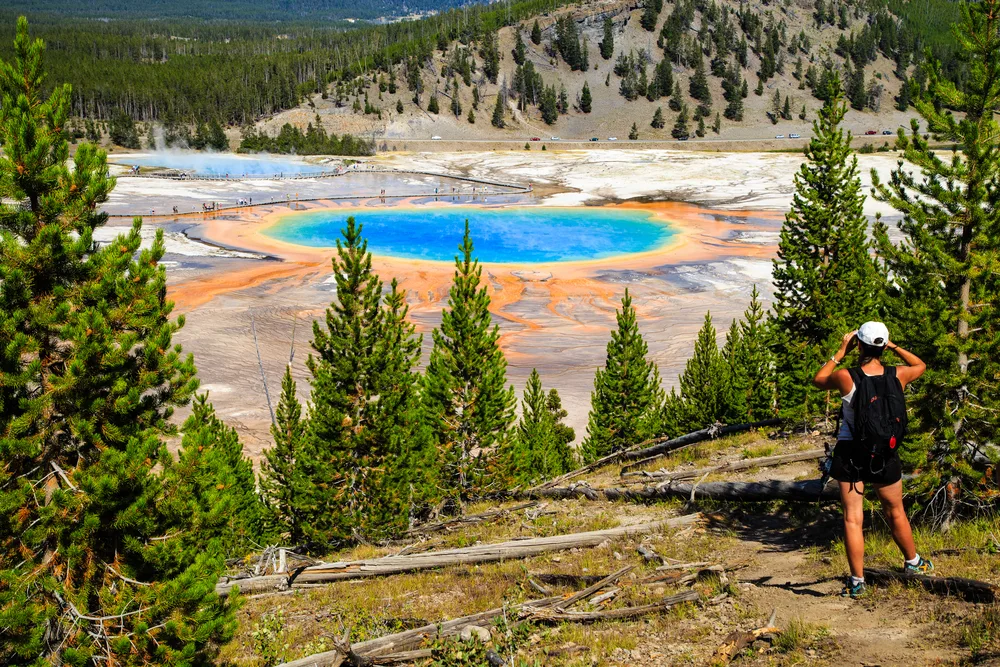
Edward Fielding/Shutterstock
Restaurant prices are higher in the park than in the gateway towns, but not outrageously so. Dinner in one of the park restaurants could run $15-$40 per person, and you might get lunch at a grill for around $10.
You may not want to eat every meal in a diner, and not only because it costs more money. If you’re out exploring, you might not be close to the nearest snack bar. You could face a choice of delaying lunch or pausing your adventure to eat.
Many tourists will choose to eat breakfast at the hotel, pack a sandwich and some trail mix for lunch, and find a restaurant where they can relax over dinner. If you’re camping, the fire pits are waiting for you.
You can break out the cookware and go all out, or you might wrap meat and vegetables in tin foil and throw it in the coals. There’s nothing like a fire-cooked meal to top off a day of exploring.
As for activity costs, well, most people have few or none. The song says that the best things in life are free, and that’s certainly true in Yellowstone. Once you pay your $35-per-carload fee for a seven-day pass, the park is yours.
You can see as many geysers and other geothermic phenomena as you can find for the same low price: $0.00. There are lakes, rivers, a canyon and countless hiking trails.
You can pick up maps at the information centers. The rangers will help you select a hike that’s suited to your skill and energy level. You may take as many pictures of wildlife as your camera will hold.
In addition, there are free educational programs where you will learn about the area’s history, both the geological history and the history of park development. You don’t have be staying at a campground to drop in on an evening campfire talk.
The park museums are free, including the Norris Geyser Basin Museum, the Museum of the National Park Ranger and the Old Faithful Visitor Information Center.
There are a few fee-based activities for those who choose them. You can arrange for horseback tours and kayak tours on Yellowstone Lake.
If you’re tired of driving, you can park your car and hop aboard a yellow bus. To fish on the lake, you’ll need a license, $40 for three days or $55 for the whole week. Boat rental is available as well.
Transportation Costs
There are 250 miles of roads in Yellowstone, and it takes wheels to see the park. Unlike some national parks, there aren’t shuttles or other public transportation services.
Some people ride the commercial tourist buses and coaches, but, for the most part, if you’re going to enjoy Yellowstone, you need a car. According to Kayak, car rental in the airport towns of Jackson, WY and Bozeman, MT will run $70-$80 per day.
It may be less in Idaho Falls. Gas in the park is more expensive than in the surrounding towns, and you can expect to put on some miles.
The park has two major loop roads, the Upper and Lower Loop, that are 142 miles and 96 miles, respectively. While the loops travel through some wild country, drivers are well supported with restaurants and gas stations at least every 15 miles.
Here’s what you get on the Lower Loop: Old Faithful, Hayden Valley and Grand Prismatic Spring. The Upper Loop takes you past Lamar Valley, Mammoth Hot Springs and Mount Washburn.
The most famous sites are also the most crowded with tourists.
It’s worthwhile to make stops at the less touristy areas where the less-famous sights are often quite as good. At any of the locations, if you get out of your car and walk for a bit, the crowd thins out.
Things to Consider
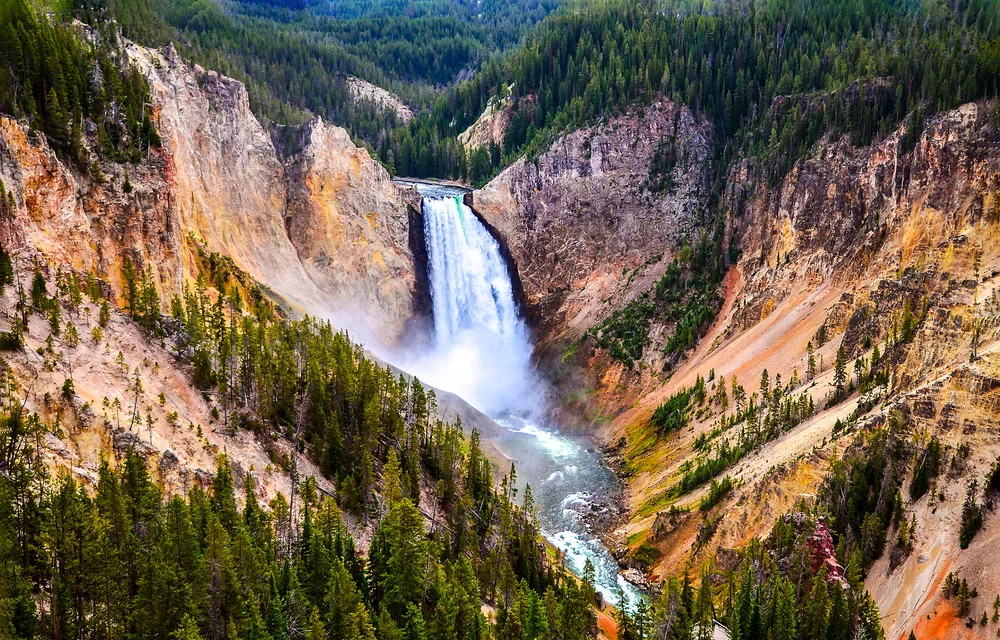
Varnak/Shutterstock
Here are some useful facts about Yellowstone National Park:
- Be prepared for all kinds of weather, even in the summer. Days are generally pleasant with temperatures in the 70s, but the mercury can plummet at night. If you’re camping, bring a warm sleeping bag or blankets. There can be snow on the mountains any time of year. Spring and fall temperatures often fall to freezing, and highs are typically in the 60s. Snow is not unusual in these seasons.
- The park is not fully open year-round. From early November to mid-April, only the north entrance is open to cars with 57 miles of road. Snowcoaches and snowmobiles may use the other entrances. Most park facilities – campgrounds, lodges, restaurants and visitor centers – are closed November through mid-December and April through mid-May.
- There are audio self-guides available for only a few dollars. If you use one of these, download before you tour as cell service is spotty. The visitors centers have a wealth of information, including Junior Ranger booklets for kids.
- Respect wildlife and keep your distance. It should go without saying that Yellowstone isn’t a petting zoo, but you’d be surprised at how many visitors stand too close to bison for photo ops.
Frequently Asked Questions
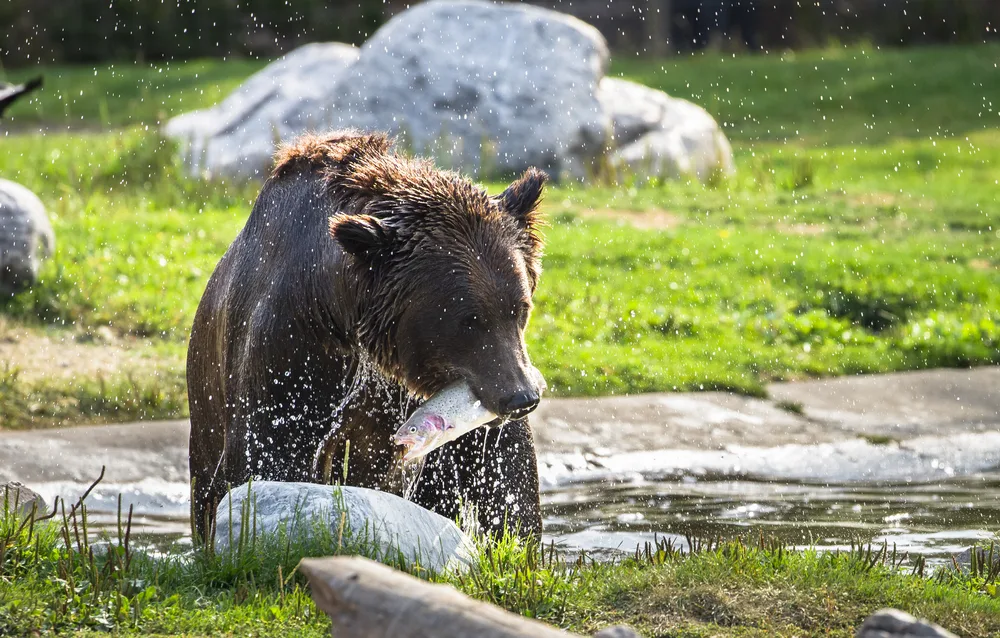
Kevin Wells Photography/Shutterstock
Here are some frequently asked question to help you budget or save a few bucks on your trip to Yellowstone:
How many days do you need for Yellowstone?
You can visit the main attractions in two days, with one day for each loop. For a more relaxed trip, three to four days allows time to explore. Longer stays are great for those who want to discover the park’s quieter, less-visited areas.
How far in advance should I reserve Yellowstone?
Reservations should be made as soon as you know your dates, up to 13 months in advance. The park opens reservations on the 5th of each month for the same month next year. Early booking ensures you get the best spots and dates.
How likely is it to see a bear in Yellowstone?
Bear sightings are possible throughout the year, especially in cooler months. They are more active during fall and spring. In summer, they tend to rest in the woods, making sightings less frequent.
Is there cell service in Yellowstone?
Cell service is available in some areas but is limited. Popular spots and hotels typically have a signal or WiFi. In more remote parts of the park, you may not have any coverage.
So, What Is the Average Cost for a Yellowstone Trip?
| 🛎️ Average Accommodation Cost | $200 per night |
| ✈️ Average Flight Cost | $400 per person |
| 🍽️ Food, Drink & Activities | $50 per person, per day |
| 🚕 Transportation | $600 total |
| 💲 Total Cost | $3,500 |
There are so many different ways to visit Yellowstone that this may not hold true for you. Many people visit the park as part of a longer driving vacation, and their costs will often be in the hundreds rather than the thousands.
Once you purchase your pass at the entrance, the park’s natural attractions are free. There’s only what you eat and drink plus gas and lodging.
Depending on how whether you fly in and how much luxury and convenience you want, your vacation for two could cost anything from a few hundred to $10,000.
So, with so much to see and do and the ability to visit this breathtaking destination on pretty much any budget, what are you waiting for — book your trip today to and experience all for yourself that Yellowstone has to offer. Happy travels!



